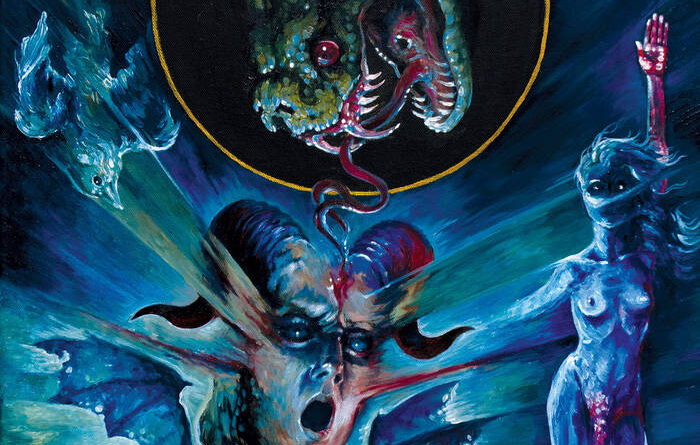ALBUM REVIEW: Dy’th Requiem For The Serpent Telepath – Esoctrilihum
You’d be forgiven for mistaking ESOCTRILIHUM as the project of a hardworking collective than the efforts of an individual, but since 2017 Asthâghul alone has maintained a consistent and impressive output. The project has produced a full-length studio album each year since its inception, each instalment populating Asthâghul’s cosmos with another fearful deity. ESOCTRILIHUM garnered considerable attention last year when Eternity Of Shaog was set upon the world; a sprawling and ambitious album, designed to invoke Shaog Og Magthoth, “the most unfathomable among the Sovereigns of Nothingness.”
Through the course of the record, Shaog is revealed to be our own malevolence and a “metaphor for both the insanity hiding in man and the solitude of the artist.” Asthâghul had achieved a new level of refinement in his musicianship, and the Lovecraftian-psychological allegory struck a chord with a wider audience. A year to the day and ESOCTRILIHUM returns with the next instalment in a series of otherworldly operas.
Dy’th Requiem For The Serpent Telepath wastes no time in setting out its agenda. From the outset it’s clear that this is a more immediate record than its predecessor, placing less emphasis on reverberant atmosphere and a great deal more on intense, confrontational rhythms. Asthâghul has been careful to retain a sense of space, though. Synthetic instruments sit high in the mix, dominating the upper registers and breathing fresh air into some dense arrangements. This is an almost impenetrable musical mélange which, while rooted in the speed and techniques of black and death metal, draws on extreme metal’s rich variety to enthral its listener at each turn. While we can applaud the commitment to stylistic diversity (especially at this length) Dy’th Requiem For The Serpent Telepath spends much of its running time at an absurd tempo: awe gives way to fatigue, and the effect is quickly diminished.
The album is divided into four parts (each consisting of three movements) which together tell the story of “the death, transfiguration and rebirth of the Serpent Telepath,” an entity which emanates from Asthâghul’s own (sub)conscious. In composing the album, Asthâghul confronts this aspect of himself and, in hearing it, we are given occasion to confront this aspect of ourselves. Though it is proxied through the lyrics and imagery of Lovecraftian horror, Dy’th Requiem For The Serpent Telepath is a more personal work than one would imagine at first blush.
So conceived it is difficult to fault the level of ambition or imagination which ESOCTRILIHUM aims at, even if the execution is often less sophisticated than one envisages. Creating at such an ambitious scale, and on such a short timescale, we cannot imagine there are many ideas left on the cutting room floor: some passages become quite protracted in the final movements, and a little more focus on articulating the album’s themes would have served the project well.
Dy’th Requiem For The Serpent Telepath demonstrates the exalted singularity which autonomous projects can achieve. Asthâghul practices a wholly unrestrained projection of the subconscious into the fantastical, producing a scintillating variety of extreme metal with symphonic flourishes. A greater focus on conceptual articulation would have improved this record immeasurably: ESOCTRILIHUM is an ambitious project, and while this latest instalment marks its next level of technical and compositional sophistication, it’s not quite a match for the scale of fantasy which Asthâghul projects.
Rating: 7/10

Dy’th Requiem For The Serpent Telepath is out now via I, Voidhanger Records.
Like ESOCTRILIHUM on Facebook.

